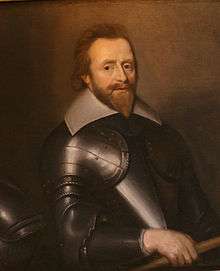Sir Charles Coote, 1st Baronet

Sir Charles Coote, 1st Baronet (1581 – May 1642) was an English soldier, administrator and landowner who lived in Ireland.
He was born into a Devonshire family, the son of Sir Nicholas Coote. In 1600 he moved to Ireland as a captain of the 100th Foot Regiment in the army of Lord Mountjoy, Lord Deputy of Ireland, where he fought in the last few years of the Nine Years War and was at the Siege of Kinsale in 1601–02 which ultimately led to the defeat of the O'Neills.
In 1605 he was appointed Provost-Marshal of Connaught for life and in 1613 was appointed to the office of General Collector and Receiver of the King's Composition Money for Connaught, also for life. In 1620 he was promoted to vice-President of Connaught and made a baronet (of Castle Cuffe in Queen's County) the following year. He became a substantial landowner and served as a commissioner to examine and contest Irish land titles. In 1634 he was appointed Custos Rotulorum of Queen's County, again for life. He was elected Member of Parliament (M.P.) in the Parliament of Ireland for Queen's County in 1639.
When the Irish Uprising of 1641 began, Coote was appointed Governor of Dublin and instructed to raise a regiment. He then marched south to secure Wicklow, marching north in 1642 to defeat the rebels at Swords and Kilsallaghan. In April 1642, he was ordered by James Butler, 1st Duke of Ormonde to relieve the beleaguered garrisons at Birr, Burris, and Knocknamease, after which he rejoined Ormonde's main force to defeat the Irish Confederates at the Battle of Kilrush in April, 1642. In early May of that year, he helped capture the garrisons of Philipstown and Trim, but was killed at Trim on 7 May 1642 during a Confederate counter-attack.
He had married Dorothea, the daughter of Hugh Cuffe of Cuffe's Wood, and had 4 sons and a daughter. He was succeeded by his son Charles, who was made Earl of Mountrath. Another son Richard became Baron Coote of Coloony.
References
- "Sir Charles Coote, 1st Baronet, d.1642". BCWProject. Retrieved 20 June 2014.
- "Sir Charles Coote". Library Ireland. Retrieved 20 June 2014.